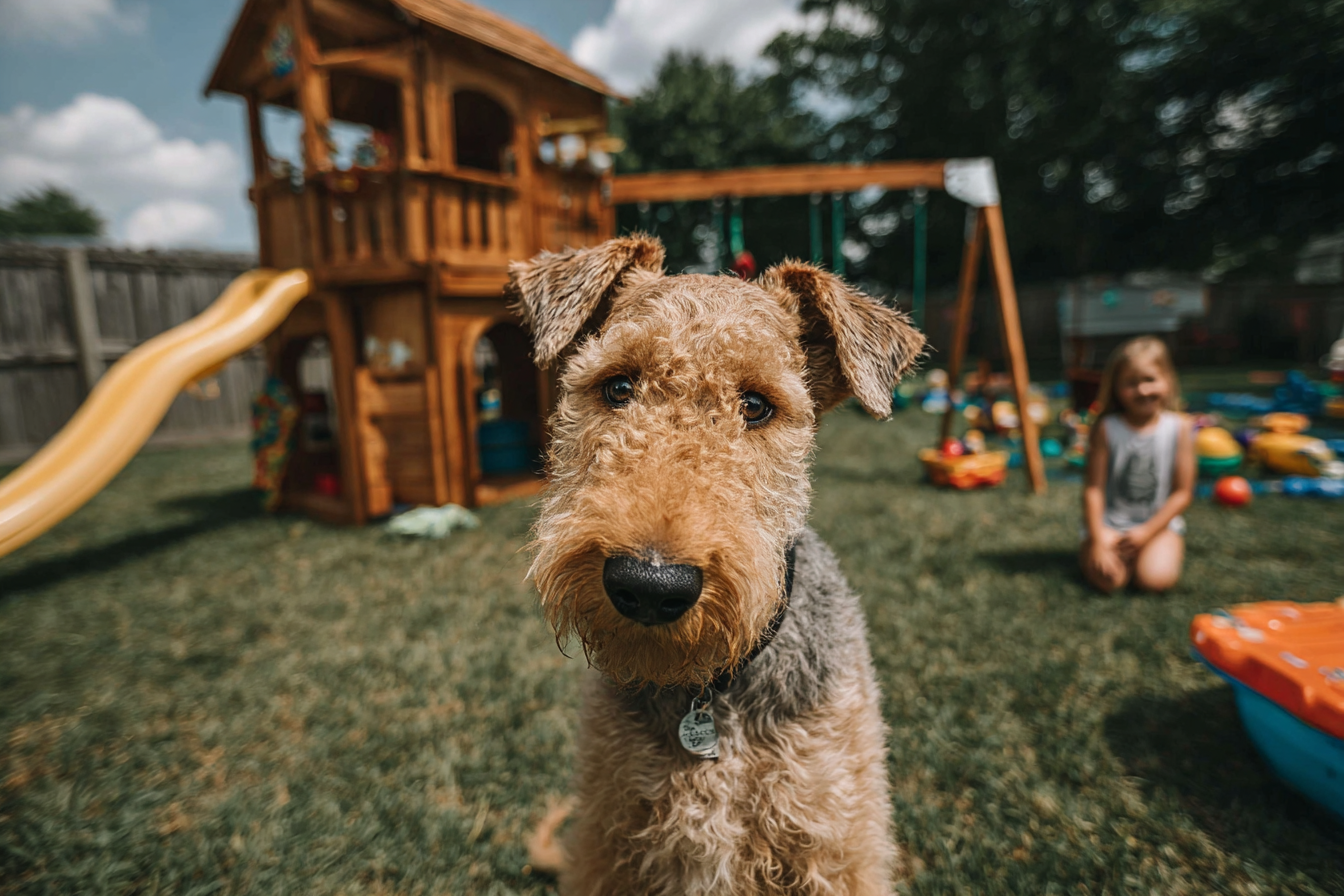When it comes to welcoming an Airedale Terrier into a family with children, understanding the dog’s temperament and how they interact with kids is key to creating a positive and safe environment. Known for their intelligence, playful nature, and loyalty, Airedale Terriers can be fantastic companions for children. However, like any breed, their characteristics and energy levels require some knowledge and preparation from parents and caregivers. This guide will help you navigate these interactions, from introductions to managing behavior, ensuring that both your Airedale and your children thrive together.
Personality Traits Relevant to Children
Airedale Terriers are often called the “King of Terriers” due to their size and confident demeanor. They are intelligent, curious, and energetic dogs with a natural eagerness to please. Their playful spirit often makes them a hit with children who enjoy active games and adventure. Airedales can be both gentle and protective, making them reliable watchdogs while also being affectionate family members.
However, their independent streak means they need consistent training and boundaries. They are not the type of dog to tolerate rough handling or unstructured interactions without guidance, so understanding their personality helps set realistic expectations about how they will behave around kids.
Age-Appropriate Introductions
Introducing an Airedale Terrier to children should be done carefully and thoughtfully to foster trust and comfort on both sides. For young children, especially toddlers, initial introductions should be brief and closely supervised. It’s important to teach children gentle approaches — no grabbing tails or ears, and no sudden movements that might startle the dog.
Older children can be involved more actively in the introduction, perhaps by offering treats or toys to the dog under adult supervision. This helps the Airedale associate children with positive experiences early on. Over time, these carefully managed introductions help build mutual respect and ease any tensions.
Supervision and Training Guidelines
Regardless of the age of the children or the dog, supervision during interactions is a must. Supervising helps prevent accidental harm, such as a dog becoming overstimulated or a child unintentionally provoking the dog. Active adult involvement ensures that boundaries are respected and behaviors corrected if necessary.
Consistent training is especially important with Airedale Terriers due to their intelligent and sometimes stubborn nature. Positive reinforcement methods work best — rewarding good behavior with treats, praise, or playtime keeps the dog motivated to learn and behave appropriately around kids. Commands such as “leave it,” “stay,” and “gentle” are useful for maintaining control during playtime or in unpredictable situations.
Teaching Children to Respect Dogs
Children need clear guidance about how to interact respectfully with an Airedale Terrier. Teaching kids to understand dog body language can prevent misunderstandings. For example, signs like a wagging tail don’t always mean a dog wants to play; it can also indicate nervousness or overstimulation.
Children should learn to:
- Approach the dog calmly and quietly
- Avoid disturbing the dog while it is eating or resting
- Use gentle petting rather than pulling or hugging tightly
- Recognize when the dog needs space and not to chase after it
By instilling respect and empathy, children contribute to a safe and loving environment for the dog.
Safety Tips for Playtime
Playtime is where Airedales shine, but it’s also a time when safety must take priority. Due to their high energy and strong build, play should be structured and supervised. Avoid games that encourage aggressive behavior like rough wrestling or tug-of-war with children, as these could escalate excitement or trigger unwanted mouthing.
Instead, games such as fetch, hide-and-seek, or agility exercises can be great options. Encourage breaks during play to prevent overexertion or frustration. Keeping play sessions positive and safe will help maintain a good relationship between the dog and the children.
Handling Energetic Behavior
Airedale Terriers are lively dogs that require ample physical and mental stimulation. Without enough outlets for their energy, they can become bored or restless, which may lead to undesirable behaviors like barking, digging, or nipping.
To manage their energy levels:
- Provide daily walks or runs tailored to the dog’s age and health
- Use puzzle toys or training games to challenge their intellect
- Set up safe play areas where they can burn off energy
By giving them appropriate outlets, an Airedale will be more relaxed and better behaved around children.
Benefits of Having an Airedale in the Family
Having an Airedale Terrier can enrich family life in many ways. These dogs are known for their loyalty and can form deep bonds with family members, including children. They encourage active lifestyles and can boost children’s social and emotional development by teaching responsibility and empathy.
Airedales also offer protection and alert families to potential dangers, making them not only companions but guardians. Their playful nature often brings joy and laughter into the home, creating a lively and heartwarming atmosphere.
Dealing with Jealousy and Attention Issues
Because of their social nature, Airedales may sometimes show signs of jealousy if they feel they are not receiving enough attention from family members. This can become an issue especially when children receive a lot of focus or when a new pet enters the household.
To manage jealousy:
- Ensure the dog gets individual quality time every day
- Acknowledge and reward calm, non-demanding behavior
- Keep routines consistent to provide stability
- Engage the dog in family activities so it feels included
Addressing these feelings proactively helps maintain a harmonious and loving environment for all.
Signs of Stress or Aggression
Even with good training and supervision, it’s essential to recognize signs of stress or aggression in Airedale Terriers to prevent conflicts with children. Common signs include:
- Growling or snapping
- Lip licking, yawning, or avoiding eye contact (stress signals)
- Stiff body posture or raised hackles
- Excessive barking or pacing
If any of these signs emerge, calmly remove the dog from the situation and allow it to relax. Consulting a professional trainer or behaviorist can be very helpful to address recurring issues or to refine training techniques.
Tips for a Harmonious Household
Creating a happy household with an Airedale Terrier and children involves commitment from the entire family. Some practical tips include:
- Establish clear house rules that everyone understands and follows
- Allocate specific times for walks, play, and rest to create structure
- Encourage children to participate in the dog’s care, such as feeding or grooming under supervision
- Maintain consistent training efforts, reinforcing positive behaviors regularly
- Promote open communication among family members about the dog’s behavior and needs
By fostering respect, patience, and understanding, families can enjoy a thriving and joyful dynamic with their Airedale Terrier.
Welcoming an Airedale Terrier into a family with children can be a rewarding experience filled with fun, companionship, and mutual respect. With thoughtful introductions, proper training, and clear communication, these lively and intelligent dogs adapt well to family life. Recognizing their unique needs and temperament helps ensure that children and their canine friend build a safe, loving, and lasting bond.







